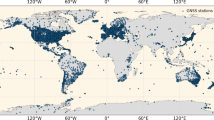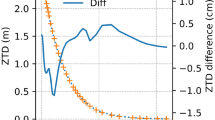Abstract
The ionosphere is recognized as a major error source for single-frequency operations of global navigation satellite systems (GNSS). To enhance single-frequency operations the global positioning system (GPS) uses an ionospheric correction algorithm (ICA) driven by 8 coefficients broadcasted in the navigation message every 24 h. Similarly, the global navigation satellite system Galileo uses the electron density NeQuick model for ionospheric correction. The Galileo satellite vehicles (SVs) transmit 3 ionospheric correction coefficients as driver parameters of the NeQuick model. In the present work, we propose an alternative ionospheric correction algorithm called Neustrelitz TEC broadcast model NTCM-BC that is also applicable for global satellite navigation systems. Like the GPS ICA or Galileo NeQuick, the NTCM-BC can be optimized on a daily basis by utilizing GNSS data obtained at the previous day at monitor stations. To drive the NTCM-BC, 9 ionospheric correction coefficients need to be uploaded to the SVs for broadcasting in the navigation message. Our investigation using GPS data of about 200 worldwide ground stations shows that the 24-h-ahead prediction performance of the NTCM-BC is better than the GPS ICA and comparable to the Galileo NeQuick model. We have found that the 95 percentiles of the prediction error are about 16.1, 16.1 and 13.4 TECU for the GPS ICA, Galileo NeQuick and NTCM-BC, respectively, during a selected quiet ionospheric period, whereas the corresponding numbers are found about 40.5, 28.2 and 26.5 TECU during a selected geomagnetic perturbed period. However, in terms of complexity the NTCM-BC is easier to handle than the Galileo NeQuick and in this respect comparable to the GPS ICA.









Similar content being viewed by others
References
Aragón-Ángel A, Orús R, Hernández-Pajares M, Juan JM, Sanz J (2006) Preliminary NeQuick assessment for future single frequency users of Galileo. In: Proceedings of the 6th geomatic week, Barcelona, Spain
Bent RB, Llewllyn SK (1973) Documentation and description of the bent ionospheric model. SAMSO technical, report, pp 73–252
Bilitza D (2002) Ionospheric models for radio propagation studies. In: Stone WR (ed) Review of radio science, 1999–2002. IEEE and Wiley, New York, pp 625–679
Brent RP (1973) Algorithms for minimization without derivatives. Prentice-Hall, Englewood Cliffs, New Jersey
Dow JM, Neilan RE, Rizos C (2009) The international GNSS service in a changing landscape of global navigation satellite systems. J Geodesy 83(3–4):191–198. doi:10.1007/s00190-008-0300-3
Di Giovanni G, Radicella SM (1990) An analytical model of the electron density profile in the ionosphere. Adv Space Res 10(11):27–30. doi:10.1016/0273-1177(90)90301-F
GLONASS Interface Control Document ICD (2008) Navigational radiosignal In bands L1, L2, Edition 5.1, Moscow
Hochegger G, Nava B, Radicella SM, Leitinger R (2000) A family of ionospheric models for different uses. Phys Chem Earth Part C Solar Terres Planet Sci 25(4):307–310
Hoque MM, Jakowski N (2008) Estimate of higher order ionospheric errors in GNSS positioning. Radio Sci 43:RS5008. doi:10.1029/2007RS003817
Hoque MM, Jakowski N (2011) A new global empirical NmF2 model for operational use in radio systems. Radio Sci 46:RS6015: doi:10.1029/2011RS004807
Hoque MM, Jakowski N, Berdermann J (2014) A new approach for mitigating ionospheric mapping function errors. In: Proceedings ION GNSS+ 2014, Sept. 8–12, Tampa, Florida
IS-GPS-200G(2012) Global positioning system directorate systems engineering and integration interface specification. ARINC Research Corporation, El Segundo
Jakowski N (1996) TEC monitoring by using satellite positioning systems. In: Kohl H, Ruester R, Schlegel K (eds) Modern ionos Sci. EGS, Katlenburg-Lindau, ProduServ GmbH Verlagsservice, Berlin
Jakowski N, Sardon E, Schlueter S (1998) GPS-based TEC observations in comparison with IRI95 and the European TEC model NTCM2. Adv Space Res 22(6):803–806. doi:10.1016/S0273-1177(98)00101-X
Jakowski N, Hoque MM, Mayer C (2011a) A new global TEC model for estimating transionospheric radio wave propagation errors. J Geodesy 85(12):965–974. doi:10.1007/s00190-011-0455-1
Jakowski N, Mayer C, Hoque MM, Wilken V (2011b) TEC models and their use in ionosphere monitoring. Radio Sci 46:RS0D18. doi:10.1029/2010RS004620
Jakowski N, Hoque MM (2012) Ionospheric range error correction models. In: Proc of international conference on localization and GNSS (ICL-GNSS), Starnberg, Germany, 25–27 June, IEEE Xplore. doi:10.1109/ICL-GNSS.2012.6253110
Klobuchar JA (1975) A first-order, worldwide, ionospheric, time-delay algorithm. United States Air Force, Air Force Systems Command, Air Force Cambridge Research Laboratories, Ionospheric Physics Laboratory, Bedford
Klobuchar JA (1987) Ionospheric time-delay algorithm for single frequency GPS users. IEEE Trans Aerosp Electron Syst AES 23:325–332
Mattos P, Petovello M (2013) Markets and multi-frequency GNSS: what will limit the spread of multi-frequency GNSS receivers into the mass market?. Inside GNSS, January/February
Minkwitz D, Gerzen T, Wilken V, Jakowski N (2014) Application of SWACI products as ionospheric correction for single-point positioning: a comparative study. J Geod 88(5):463–478. doi:10.1007/s00190-014-0698-8
Naoki A, Kazuaki H (1998) Correction of ionospheric delay on GLONASS using the GPS navigation message. In: Proceedings of the 1998 national technical meeting of the Institute of Navigation, Long Beach, pp 667–671
Nava B, Coisson P, Radicella SM (2008) A new version of the NeQuick ionosphere electron density model. J Atmos Terres Phys (JASTP) 70(15):1856–1862. doi:10.1016/j.jastp.2008.01.015
Noll Carey E (2010) The crustal dynamics data information system: a resource to support scientific analysis using space geodesy. Adv Space Res 45(12). ISSN 1421–1440:0273–1177
Os SISICD (2010) European GNSS galileo open service signal in space interface control document, SISICD-2006. Eur Space Agency, issue 1:1
Prieto-Cerdeira R, Orús-Pérez R, Breeuwer E, Lucas-Rodriguez R, Falcone M (2014) Performance of the Galileo single-frequency lonospheric correction during in-orbit validation. GPS World 25(6):53–58
Radicella SM, Zhang ML (1995) The improved DGR analytical model of electron density height profile and total electron content in the ionosphere. Annali di Geofisica 38:35–41
Radicella SM, Leitinger R (2001) The evolution of the DGR approach to model electron density profiles. Adv Space Res 27(1):35–40. doi:10.1016/S0273-1177(00)00138-1
Radicella SM, Nava B, Coisson P (2008) Ionospheric models for GNSS single frequency range delay corrections. Fisica de la Tierra 20:27–39
Rawer K (1963) Propagation of decameter waves (h.f. band). In: Landmark B (ed) Meteorological and astronomical influences on radio wave propagation. Pergamon Press Inc., Oxford
Schaer S, Beutler G, Rothacher M (1998) Mapping and predicting the ionosphere. In: Dow JM, Kouba J (eds) Proceedings of the 1998 IGS analysis center workshop, Darmstadt, February 9–11. Springer, Berlin, Darmstadt, pp 307–318, ESA/ESOC
Schlüter S, Beniquel Y, Bourga C, Arbesser-Rastburg B, Jakowski N, Amarillo F, Klahn D, Noack T (2004) Ionosphere related contribution of the atmospheric processing and assessment facility to GSTB-V1. In: Proceedings of the European navigation conference, 16–19 May, Rotterdam, The Netherlands
Urlichich Y, Subbotin V, Stupak G, Dvorkin V, Povalyaev A, Karutin S (2011) GLONASS: developing strategies for the future. GPS World 22(4):42–49
Acknowledgments
We would like to express our gratitude to the editor and reviewers for their helpful remarks for improving the manuscript. Further, we would like to express our gratitude to the Aeronomy and Radio Propagation Laboratory of the Abdus Salam International Centre for Theoretical Physics Trieste/Italy providing NeQuick version 2.0.2 for scientific purposes. We would like to give thanks to sponsors and operators of NASA’s Earth Science Data Systems and the CDDIS for archiving and distributing the IGS data. We would like to acknowledge the support of the organizations contributing to the IGS by providing GNSS data to the CDDIS for the international science community. We are grateful to NOAA’S NGS for publishing Continuously Operating Reference Stations (CORS) data. We are also grateful to CODE for making public the global ionospheric TEC maps. We would like to give thanks NOAA’s NGDC for disseminating historical solar and magnetic data via SPIDR. Also thanks to SOPAC service for making available daily GNSS satellite ephemeris data.
Author information
Authors and Affiliations
Corresponding author
Rights and permissions
About this article
Cite this article
Hoque, M.M., Jakowski, N. An alternative ionospheric correction model for global navigation satellite systems. J Geod 89, 391–406 (2015). https://doi.org/10.1007/s00190-014-0783-z
Received:
Accepted:
Published:
Issue Date:
DOI: https://doi.org/10.1007/s00190-014-0783-z




